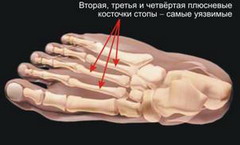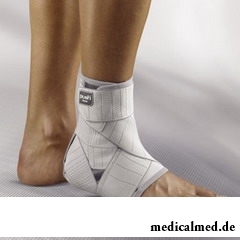





Foot change
The change of foot needs special attention and careful leaving as each bone in foot is closely interconnected with others, any  shift or injury of one bone can lead to disturbance or deformation of others. Also owing to a change of foot musculoskeletal system diseases, for example, flat-footedness or arthrosis can develop. Changes of foot make about 2,5-10% of number of all changes.
shift or injury of one bone can lead to disturbance or deformation of others. Also owing to a change of foot musculoskeletal system diseases, for example, flat-footedness or arthrosis can develop. Changes of foot make about 2,5-10% of number of all changes.
Foot change reasons
The fracture of bones of foot can arise because of:
• kick;
• landings on legs during a jump from big height;
• falling of heavy things on foot;
• a foot incomplete dislocation during circulation on uneven surfaces.
Types of a change of foot
1. Fracture of bones of manual phalanxes;
2. Fracture of a plusnevy bone of foot (including fracture of the 5th plusnevy bone of foot);
3. Fracture of a tarsal bone.
Symptoms of a fracture of bones of foot
The general symptoms of a fracture of bones of foot are pain and hypostasis of fabrics, nearby from the place of a change.
Symptoms of a fracture of plusnevy bone of foot (including fracture of the 5th plusnevy bone of foot):
• deformation of foot;
• pain during palpation and a support on foot;
• hypostasis on a sole and, sometimes, the foot back.
Symptoms of a fracture of bones of manual phalanxes:
• presence of hematomas;
• pain during movements and a palpation;
• hypostasis and posineniye of a sore finger.
Symptoms of fractures of tarsal bones of foot:
• hemorrhages on integuments;
• sharp pain during turns of foot and a support on it;
• puffiness of soft tissues in an ankle joint and the place of a change.
Foot change symptoms with shift:
• noticeable puffiness of all foot;
• strong deformation of foot;
• sharp pains in the place of a change.
Treatment of a change of foot
 Metatarsus bones. During usual changes impose the plaster tire for one month. When there is a shift of fragments, bones set in the closed way and fix gypsum for six weeks.
Metatarsus bones. During usual changes impose the plaster tire for one month. When there is a shift of fragments, bones set in the closed way and fix gypsum for six weeks.
Tarsus bones. If there is no shift, fix the circular plaster tire for a period of three weeks up to five-six months. If there are shifts of fragments of a bone, make their reposition (recovery of the necessary situation) and impose skeletal traction.
Bones of manual phalanxes. Apply a plaster bandage for a period of up to six weeks depending on weight of a change. If there is a shift, bone fragments in addition fix by means of spokes.
Insignificant cracks and fractures of bones of foot can treat without use of plaster bandages. In such cases foot is fixed by means of a bandage or special protective footwear. To lower loads of foot, crutches are applied.
Sometimes also appoint drugs for internal reception. Often, it is antiinflammatory and vitamin drugs.
Recovery after a foot change
The rehabilitation period depends on duration of imposing of a retentive bandage and weight of a change.
If there is a fracture of a plusnevy bone of foot, it is recommended to go in for the sparing medical physical culture for two months. During it there can sometimes be a popedema. If there was a shift after fixation by gypsum, make its replacement by the back bandage from gypsum having a thickening on a heel (heel) which needs to be carried on an extent of two-three weeks. After gypsum will be removed, the patient will need to use orthopedic insoles.
Fractures of tarsal bones need longer period of recovery. Massage, physical therapy, the sparing physical culture and carrying instep supports are shown. For two-three months all events for rehabilitation have to be held under supervision of doctors. Instep supports rush not less than one year.
If there was a fracture of manual phalanxes, the patient needs every day the kneading massage. Not less than five months are also desirable to wear orthopedic shoes.
Drug for cough Terpinkod is one of leaders of sales, not because of the medicinal properties at all.

80% of women at least once to lives complained of discomfortable feelings to breasts, consolidations and nagrubaniye. These are mastopathy symptoms. Mas...
Section: Articles about health
From sexual contacts each person can test insufficiently strongly expressed sexual desire or lack of satisfaction from time to time. However when it happens regularly, it is an occasion to think about health. Most of people does not hurry an obrashcha...
Section: Articles about health
It would seem, about it there can be no disagreements: water is necessary for a human body for normal life activity, and about how and when it should be drunk, all know. It turned out that the situation is not absolutely so: for many years there are very persistent delusions connected with this question. Let's consider the most widespread of them....
Section: Articles about health
For the person who daily since morning gathers for work it is very important to wake up vigorous and ready by day of work. On most...
Section: Articles about health
History of cultivation of a buckwheat contains more than five thousand years. Grain which is received from this plant is used for preparation of porridges, soups, baked puddings and puddings, do flour which is one of the main ingredients of the noodles popular in of it...
Section: Articles about health
Contrary to popular belief, the multiple sclerosis (MS) is not connected neither with sclerous changes of walls of vessels, nor with age forgetfulness and problems with concentration of attention. This disease has the autoimmune nature. Pathological process is expressed in degradation of nervous tissue and destruction of its enveloping layer - a myelin. Multiple damages of the central nervous system which are shown by decrease in sight, bystry fatigue, on become result of development of an illness...
Section: Articles about health
Aspirin (acetylsalicylic acid) – one of those drugs which are known literally to all. It is available in each home first-aid kit...
Section: Articles about health
Turnip, radish, horse-radish – once these and other products enjoyed wide popularity at our ancestors, being not only the food sating an organism but also the medicines curing of many diseases. Unfortunately, having given the use of some of them...
Section: Articles about health
The trophic ulcer is not an independent disease. This heavy complication arising owing to a thermal injury (a burn or a frostbite), chronic pathologies of arteries or veins of the lower extremities, a diabetes mellitus, and also some defeats of connecting fabric, absorbent vessels, skin or nervous trunks. Pathology is shown in the form of not healing wound located on the internal surface of a shin, a foot sole, a heel or toes....
Section: Articles about health
The words "disease" and "patient" not without reason come from one root – "pain". As a rule, symptoms of illnesses thoroughly spoil the patient...
Section: Articles about health
The unpleasant feelings connected with spring breakdown are familiar almost to each of us. Often happens that in March-April on the person weakness leans: he suffers from drowsiness, complains of bad mood, loss of interest in life and failures in affairs....
Section: Articles about health
One of the useful properties presented to the person by the nature is ability to feel fear. This ability is designed to signal about approach of a dangerous situation and to help to avoid in advance it to keep life. However if the fear is persuasive and is not reasonable, it can seriously limit possibilities of the person in respect of socialization and self-realization. Such pathological fear is called a phobia....
Section: Articles about health
What will only not be thought up by persons interested to have a beautiful figure. Here the last innovation – for weight loss needs to be eaten greasy food. Give ра...
Section: Slideshow
The majority of gynecologic diseases prove three main signs, each of which speaks about need of a visit to the gynecologist. Certainly, it is possible to establish the exact diagnosis only after inspection, but on the basis of some signs it is possible пр...
Section: Articles about health
Since the moment when the child becomes a school student, his sight begins to be exposed to the strengthened loadings which are supplemented with viewing of animated films and long computer games. During this period of life of the child development of not completely created organs of sight, it is very easy to break the excessive loading which is aggravated with lack of a work-rest schedule. As a rule, and occurs: according to WHO statistics, every fourth child of school age has these or those diseases of eyes, Wednesday...
Section: Articles about health
From the failure of work of immune system which is shown in the form of an allergy, statistically, more than 40% of the population of the globe suffer. In большинс...
Section: Articles about health
History of mankind contains several tens of epidemics whose emergence was compared by eyewitnesses and historians to doomsday. The most terrible of them claimed the lives of millions of people, having made even the whole people to the person of the earth. What they − the diseases striking terror? Daringly...
Section: Articles about health
The immunity role in growth of the child is invaluable. The proteins-immunoglobulins produced by immune system preserve the child against the diseases capable − owing to an organism weak still − to serve as a stressful factor, to become the reason of many complications and delays in development of the kid. If the immune system weakened, health of the child is under direct threat and needs active actions for strengthening of protective forces of an organism − preferably non-drug....
Section: Articles about health
Aging — natural and inevitable process. Over time our skin loses elasticity, on it saggings, a face form теря are formed...
Section: Articles about health
The technique of acupuncture (acupuncture) is used in the medical purposes more than three and a half millennia. It is eurysynusic and recognized as official medicine in the majority of the developed countries of the world. Influence by fine needles on so-called points...
Section: Articles about health
Ayurveda - the most ancient tselitelsky practice which came to us from India. It represents the doctrine about maintenance of physical, psychological and moral health of the person by means of the complex of procedures including a diet, cleaning of an organism, breathing exercises, massage, and in case of a disease - and medicinal therapy. The healers practicing Ayurveda assign very important part to spices, and at the heart of Ayurvedic drugs, as a rule, there are they. It is considered that spices not of t...
Section: Articles about health
EKO, or extracorporal fertilization - a method of treatment of infertility which became the reason of a set broken mines in due time...
Section: Articles about health
Feeding by a breast - the integral part of ideal motherhood allowing to come into contact with the kid and to create to it healthy immunity since early years. Nevertheless, this important process in life of mother and child can be saddened laktostazy − by a delay of milts...
Section: Articles about health
Diapers for adults – individual one-time means of hygiene which in some situations is irreplaceable and from such situations any person is not insured. Though nobody perceives need of their use with enthusiasm, however without such means already problematic situation could be heavier....
Section: Articles about health
No, probably, the person who would not have cold. Cold, cough, a headache – these symptoms are known to everyone. Peak to Prost...
Section: Articles about health
The popular expression "run from a heart attack" became the motto of the people supporting active lifestyle. Moreover, run became a peculiar fashionable tendency: sales of racetracks and the accompanying goods for run are at permanently high level. Really...
Section: Articles about health
Dietary supplements (dietary supplements) for the last decades were so thoroughly included into our life that, apparently, it is already impossible to find the person who at least once did not try them. At the same time, most of our compatriots have a vague idea of what dietary supplements as they affect a human body consist of and what differ from the real medicines in. Let's try to understand these questions, and at the same time and to understand, such additives are how necessary for us....
Section: Articles about health
